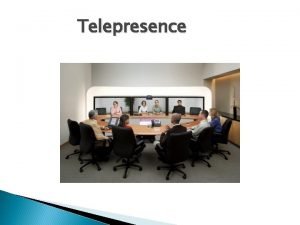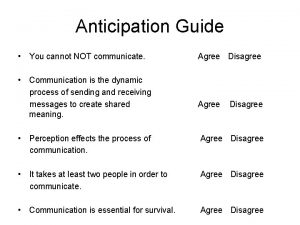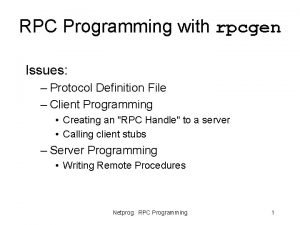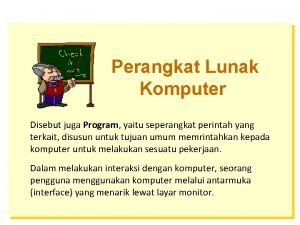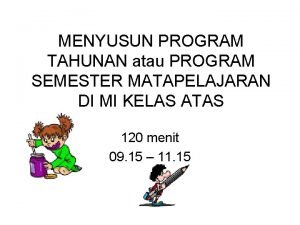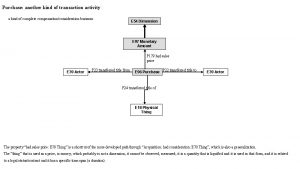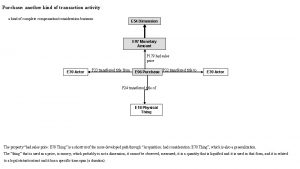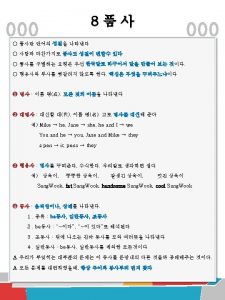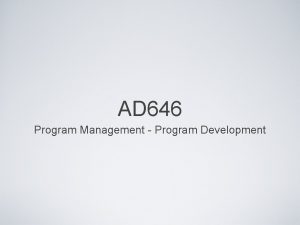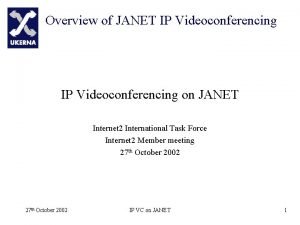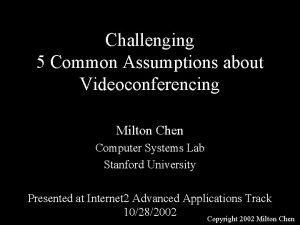Not that kind of chatroom A videoconferencing program


































- Slides: 34

Not that kind of chatroom: A videoconferencing program CIT continuing education CIT International Conference August 15, 2018

TODAY’S PANEL Detective Benjamin Melendrez Detective Lawrence Saavedra Detective Matthew Tinney 2

Learning objectives ▪ ▪ ▪ 3 Identify the need for continuing education for law enforcement in the areas of mental health and substance use. Describe how the CIT ECHO is being used to train law enforcement throughout New Mexico and the country. Describe the mixed methods approach being used to evaluate the CIT ECHO program and understand implications of the evaluation’s findings.

Why do we need more accessible continuing education for CIT? 4

Multiple Points of Interaction between Police and Individuals with Mental Illness and Substance Use Disorders History of police arrest 25% of people with serious mental illness have histories of police arrest 25% Calls for Service 5% of police calls for service involve people with behavioral health problems 5% 12% Pathway to care 12% of individuals have police involved in their pathway to mental healthcare Source: Livingston, J. D. (2016). Contact Between Police and People With Mental Disorders: A Review of Rates. Psychiatric Services, 67(8), 850– 857.

There is tremendous variation in the type and amount of training police departments provide for their officers in how to respond to people in behavioral health crisis Continuing education and specialized trainings do not receive the same degree of attention as entry level training Funding opportunities for field officers remains a top concern for many departments 6 Source: Plotkin, M. , & Peckerman, T. (2017). The Variability in Law Enforcement State Standards: A 42 -State Survey on Mental Health and Crisis De-escalation Training. The Council of State Governments Justice Center.

The Number Of Behavioral Health Related Calls By Year for APD Source: Winograd, Peter and Brown, Kylynn. The Albuquerque Police Department Crisis Intervention Unit Data Book: A Working Compendium. June 15, 2018.

Traditional CIT Training 40 hour class. Limited upkeep. ?

GRANT FUNDING & TIMELINE • • $250, 000 for a three year grant: 10/1/2015 – 9/30/2018 BJA FY 2015 Justice and Mental Health Collaboration Program: Planning and Implementation Grant 2014 APD attends Project ECHO Clinic 201 5 Received BJA Grant Funding 201 6 Launch of First CIT ECHO Present 116 ECHO Sessions Held

Partners: • Albuquerque Police Department • Project ECHO • University of New Mexico, Department of Psychiatry & Behavioral Sciences, Division of Community Behavioral Health • Crisis Intervention Team Inc. • Presbyterian Healthcare Services Implementing the CIT ECHO 10

PROJECT ECHO CORE CONCEPTS Video-Conferencing Network Hub & Spoke Model Case Based Learning Demonopolizing Knowledge Develops Subspecialty Expertise Over Time

CIT ECHO FACILITATION 12

Traditional CIT Training The CIT ECHO Model ! 40 hour class. Limited upkeep. ! ! ? ? ! !

Each CIT ECHO Session Consist of Two Parts Brief Debriefing (45 minutes) DIDACTIC 14 CASES

DIDACTICS Curriculum Modules: CIT Policing Psychiatric Diagnoses Substance Use De-escalation & Communication Officer Self-Care Resources Special Trainings 15

DIDACTIC CURRICULUM 1. CIT POLICING 3. SUBSTANCE USE 5. OFFICER SELF-CARE Barricade Situations International Drug Trafficking Tactics for Officer Well-Being Suicide by Cop Suboxone vs. Methadone Mindfulness Communicating with Doctors Alcohol Use Disorder Exercise in the Treatment of Depression Certificates of Evaluation Opioid 101 for Law Enforcement 6. RESOURCES 2. PSYCHIATRIC DIAGNOSES Common Drug Street Names New Mexico Crisis & Access Line Bipolar Affective Disorder Cannabis Myth Busting NAMI: An Overview of Services Schizophrenia 4. DE-ESCALATION & COMMUNICATION APD’S C. O. A. S. T. Program Psychosis Basics of the PURE Model 7. SPECIAL TRAININGS Paranoia Active Listening Skills Transgender 101 Autism Spectrum Disorders Verbal Judo Media’s role in Reporting Mass Shootings PTSD 16 Motivations of a Serial Killer

Debriefing Template DEBRIEFING CASES 17

Case Example Collateral: Female, 94 y. o. , good physical health, recent hospitalization, prior contact with family reference female’s erratic behavior Reason for contact: Subject refusing to exit taxi cab and wanted to be driven to a party for family member celebrating the death of an ex-spouse, this turned out to be a delusion. Family members called for police assistance and officers on-scene called the on-call CIU detective.

Case Example Clarifying Questions How quick was the onset to her behaviors? Has she been treated for any infections? Was she on any medications and what were they? History of dementia, violence, or drug use? Availability of weapons?

Case Example Outcomes Short-term Subject admitted to geriatric unit, received treatment and was given a discharge plan with prescribed medications Long-term Treatment Guardian Admitted to long-term care facility

BENEFITS OF CASE DEBRIEFING CIT ECHO works hand-in-hand with the Crisis Intervention Unit 21

Evaluating the CIT ECHO 22

Mixed Methods Approach 1. Online surveys to assess impact on knowledge related to the content presented in the session (weekly) 2. Online surveys to assess satisfaction with the technology and curriculum and impact on self-efficacy (3+ sessions) 3. Semi-structured interviews with stakeholders to obtain feedback about the face validity and practical utility

Participating Agencies: January 2017 – July 2018 Albuquerque Ambulance Service Albuquerque Fire & Rescue Albuquerque Police Department American University of Antigua Aurora, IL Police Department Bernalillo County, NM Sheriff’s Office Chicago, IL Police Department Comprehensive Healthcare Yakima, WA Dayton, OH Police Department Everett, WA Police Department Gastonia, NC Police Department Huntington, WV VA Medical Center Jicarilla Apache Police Johnston County, NC Mental Health Center King County, WA Sheriff’s Office Las Cruces, NM Police Department Mc. Kinley County, NM Sheriff’s Office 24 New Mexico Law Enforcement Academy New Mexico Probation & Parole New Mexico State Police New York EMS North Richland Hills, TX Police Department Ontario Canada Police College Pinellas County, FL Sheriff’s Office Portland, OR Police Bureau Rio Arriba County, NM Sheriff’s Office Rio Rancho, NM Police Department San Juan County, NM Sheriff’s Office St. Martin’s Mobile Crisis Teams St. Paul, MN Police Department Stevens Point, WI Police Department Tulane University U. S. Probation & Parole Wicomico County, MD Health Department

Process Data: January 2017 – July 2018 34 Agencies 203 unduplicated participants 28. 2 participants per session 100. 73 hours of continuing education 51 calls for service debriefed 25

PARTICIPANT DEMOGRAPHICS 26

PARTICIPANT DEMOGRAPHICS 27

EVALUATING OUR EFFECTIVENESS • To what extent did the information in this week’s session improve your knowledge of the presentation topic? • How likely are you to use the information that you learned in this week’s session in your job? • To what degree did this week’s session impact your knowledge of resources in the community? • After attending this week’s session how would you now rate your ability to interact with an individual in a mental health crisis? 28

Session Impact on Perceived Ability to Interact with Individuals with Mental Illness for all CIT ECHO Didactics % Very Much 21. 1% %Much %Not at All 14. 1% 63. 8% 18. 2% 31. 0% 8. 7% 51. 0% 62. 3% Self-care/stress management 1. 0% Resources 3. 4% 68. 3% 42. 9% Special Training 3. 0% 16. 2% 51. 7% 23. 0% Substance Use 2. 1% 18. 2% 65. 7% 13. 8% Grand Total 2. 0% 10. 6% 60. 6% 17. 1% 29 %Very little 62. 7% 23. 4% 18. 8% %Somewhat 6. 1% 15. 2% Psychiatric Diagnoses De-escalation/communication 3. 7%CIT Policing

What’s Next? Success • Changes to SOPs and curriculum/training • Identification of best practices Challenges • Officers debriefing cases • Meeting time doesn’t work for all officers 30

THANK YOU! ANY QUESTIONS? Contact Information: Detective Benjamin Melendrez - bmelendrez@cabq. gov Detective Lawrence Saavedra - ldsaavedra@cabq. gov Detective Matthew Tinney - mtinney@cabq. gov 31

Using Zoom 32

Zoom can be downloaded to smart phones, tablets, computers, and officers’ mobile tough books Place your screenshot here 33

MEETING ID: XXX-XXXX Important Zoom Features 34
 Disadvantages of telepresence
Disadvantages of telepresence Ngoại tâm thu thất chùm đôi
Ngoại tâm thu thất chùm đôi Block av độ 2
Block av độ 2 Thể thơ truyền thống
Thể thơ truyền thống Thơ thất ngôn tứ tuyệt đường luật
Thơ thất ngôn tứ tuyệt đường luật Chiến lược kinh doanh quốc tế của walmart
Chiến lược kinh doanh quốc tế của walmart Tìm độ lớn thật của tam giác abc
Tìm độ lớn thật của tam giác abc Con hãy đưa tay khi thấy người vấp ngã
Con hãy đưa tay khi thấy người vấp ngã Tôn thất thuyết là ai
Tôn thất thuyết là ai Gây tê cơ vuông thắt lưng
Gây tê cơ vuông thắt lưng Sau thất bại ở hồ điển triệt
Sau thất bại ở hồ điển triệt Not genuine not true not valid
Not genuine not true not valid No one is respectable or unhappy over the whole earth
No one is respectable or unhappy over the whole earth Matthew 17:4
Matthew 17:4 If you are not confused you're not paying attention
If you are not confused you're not paying attention Informal casual
Informal casual Attention is not explanation
Attention is not explanation Not too broad and not too narrow
Not too broad and not too narrow Negation of if then
Negation of if then Too big too small just right
Too big too small just right Love is not all analysis
Love is not all analysis Eyes that see and ears that hear
Eyes that see and ears that hear Sit pp
Sit pp What you don't measure quote
What you don't measure quote We will not be shaken we will not be moved
We will not be shaken we will not be moved Not a rustling leaf not a bird
Not a rustling leaf not a bird You cannot not communicate
You cannot not communicate Program to an interface, not an implementation
Program to an interface, not an implementation Adapter vs strategy pattern
Adapter vs strategy pattern Clnt_create: rpc: program not registered
Clnt_create: rpc: program not registered Differences between sequential and event-driven programming
Differences between sequential and event-driven programming Perangkat lunak komputer di sebut
Perangkat lunak komputer di sebut Program tahunan adalah
Program tahunan adalah Microsoft excel merupakan program aplikasi....
Microsoft excel merupakan program aplikasi.... Yang bukan kegunaan program pengolahan angka adalah
Yang bukan kegunaan program pengolahan angka adalah
